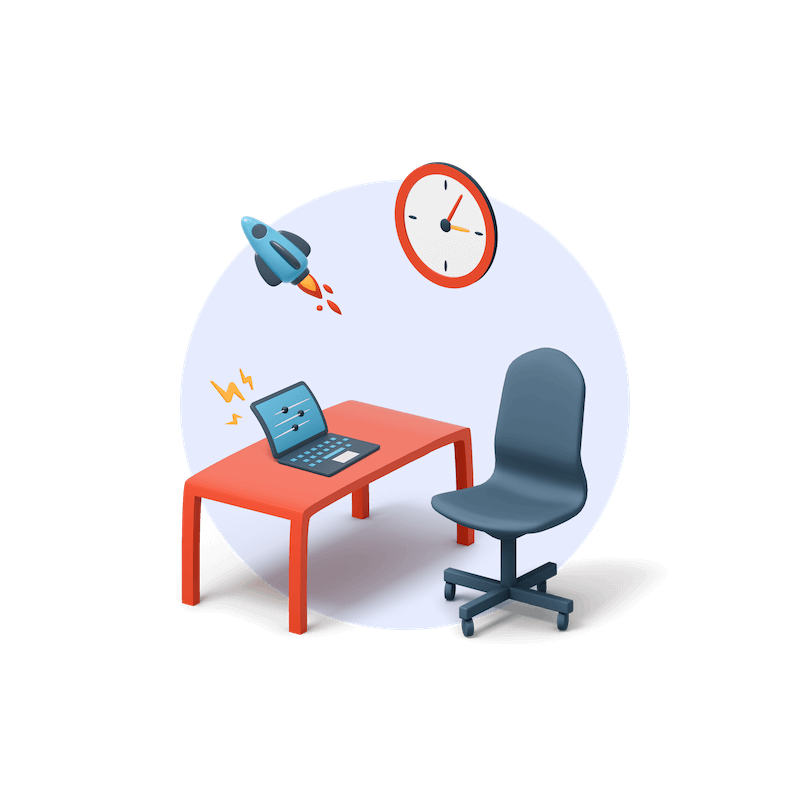When it comes to hiring an employee, deciding on part-time or full-time should be an easy decision. Surely you just need to know how many hours you need to fill, right? Not quite.
The difference between a part-time and full-time employee is much more than the hours they work.
Hiring a part-time worker or a full-time worker has many advantages and disadvantages you probably haven’t thought of. Luckily this guide will explain the key differences between part-time and full-time and the advantages and disadvantages of each work mode.
Table of Contents
Key Differences Between Part-time and Full-time
Each company defines part-time and full-time differently. However, full-time is generally understood to be about 40 hours a week. But as an employer, there are many differences between part-time and full-time beyond the number of hours an employee works.
Salaries have to be paid differently, and there are different regulations and legal ramifications for each. Work schedules differ, and full-time work entails different employee benefits and health insurance. We’ll break down how part-time and full-time work is different in these respects below.
Law & Regulations
Despite differing company definitions of part-time and full-time work, some laws and regulations clearly define the two. The two main U.S. laws and regulations that pertain to part-time and full-time work are the Affordable Care Act and the Fair Labour Standards Act.
The Affordable Care Act
The Affordable Care Act defines full-time work as an average of 30 hours a week or 130 hours a month. If a business has 50 or more full-time employees, they are entitled to an affordable health care plan. That’s because they’re categorized as an Applicable Large Employer (ALE).
The Fair Labour Standards Act
The Fair Labour Standards Act pertains to overtime. Any nonexempt employees working more than 40 hours a week are entitled to overtime for any hours worked over 40 hours. The act applies to businesses of all sizes.
Hours worked
As we have already touched upon, there is no clear answer to how many hours worked constitutes full-time. Even the Fair Labor Standards Act has no clear definition. The two legal definitions covered in the previous section define full-time differently as well.
However, despite different legal and company definitions, there is a consensus on how many hours are considered part and full-time.
The Bureau of Labor Statistics definition of 35 hours for full-time work is a good reference point for what is considered full-time work. Some companies may consider 30-plus hours a week full-time, but the consensus is full-time is around 35-40 hours a week.
A nine-till-five work week with a two-day weekend is 40 hours, which is generally considered a full-time job.
Work schedules
Full-time work schedules are usually a rigid set of hours, like 9 am to 5 pm, Monday to Friday. Overtime may be expected, but the typical work schedule rarely changes. On the other hand, part-time work schedules are generally more flexible.
A part-time employee may work three eight-hour shifts one week and then two ten-hour shifts and a six-hour shift another week, or a 2-2-3 schedule.
Also, part-time employees are more likely to work split shifts and alternating schedules, as part-time work is often sought, so the employee has time for other commitments.
A split shift allows a part-time employee to work their shift in two parts, so they have time to pick up their children from school, for example. An alternating schedule is when an employee, usually part-time, has a differing schedule from week to week to accommodate outside commitments.
Health Insurance
As mentioned in the laws & regulations section, the Affordable Care Act entitles full-time employees (defined as 30 or more hours a week) access to an affordable employer-sponsored healthcare plan. So the main difference is, legally, you only need to provide your full-time employees with health insurance.
But many companies will also provide health insurance to their part-time employees. Health insurance is considered a “very important” factor in an employee’s decision to take or keep a job, so it’s well worth offering even to part-time employees.
Salary payment
A salary payment compensates an employee with a fixed and regular payment, typically once a month. A salary is usually expressed as an annual fee, for example, $35,000.
Full-time workers, especially professionals, are usually salaried. Part-time workers are more likely to be paid an hourly rate but can also be salaried; whether an employee is salaried or paid by the hour does not define their part or full-time status.
Employee benefits
Some benefits are mandated by law for all employees. Below are the main benefits that must be offered to your employees, regardless of whether they are part-time or full-time. But this is a general overview and not legal advice, so consult a legal professional for the full list in your state.
FMLA
Family and Medical Leave is one benefit mandated by law; FMLA entitles employees to paid time off for specific family and medical reasons.
Employees must work over 1,250 hours a year, which averages 24 hours a week, to be eligible, so all full-time employees are covered, as well as some part-time employees.
But FMLA only applies to businesses with at least 50 employees within 75 miles and employees who have worked at the company for at least 12 months.
Unemployment insurance
All employees must contribute to unemployment insurance to help ex-employees financially if they lose their job. Unemployment insurance contributions are made through payroll taxes at the federal and state level.
Those eligible for unemployment insurance include employees who are let go due to layoffs, mergers, or termination without substantial proof. The cost of insurance and minimum requirements for employees varies from state to state.
Workers’ compensation insurance
As an employer, you are required to provide financial support for employees unfit for work due to workplace injuries or illnesses. The financial support covers medical bills and a percentage of the employee’s income. The scope of financial aid differs from state to state.
But not all employee benefits are mandated by law; they are up to the individual business. Generally, employee benefits will be better for full-time employees, as they are a way for a business to entice the best talent in their full-time roles.
Offering comprehensive benefits packages is important, as 69% of employees would choose one job over another if it offered better benefits.
Here’s a short list of the kind of benefits that are typically offered:
Paid employee leave and holidays
Pension schemes
Healthcare
Company cars and expenses
Life insurance
Gym memberships
Relocation expenses
Student loan repayments
Paid training and development
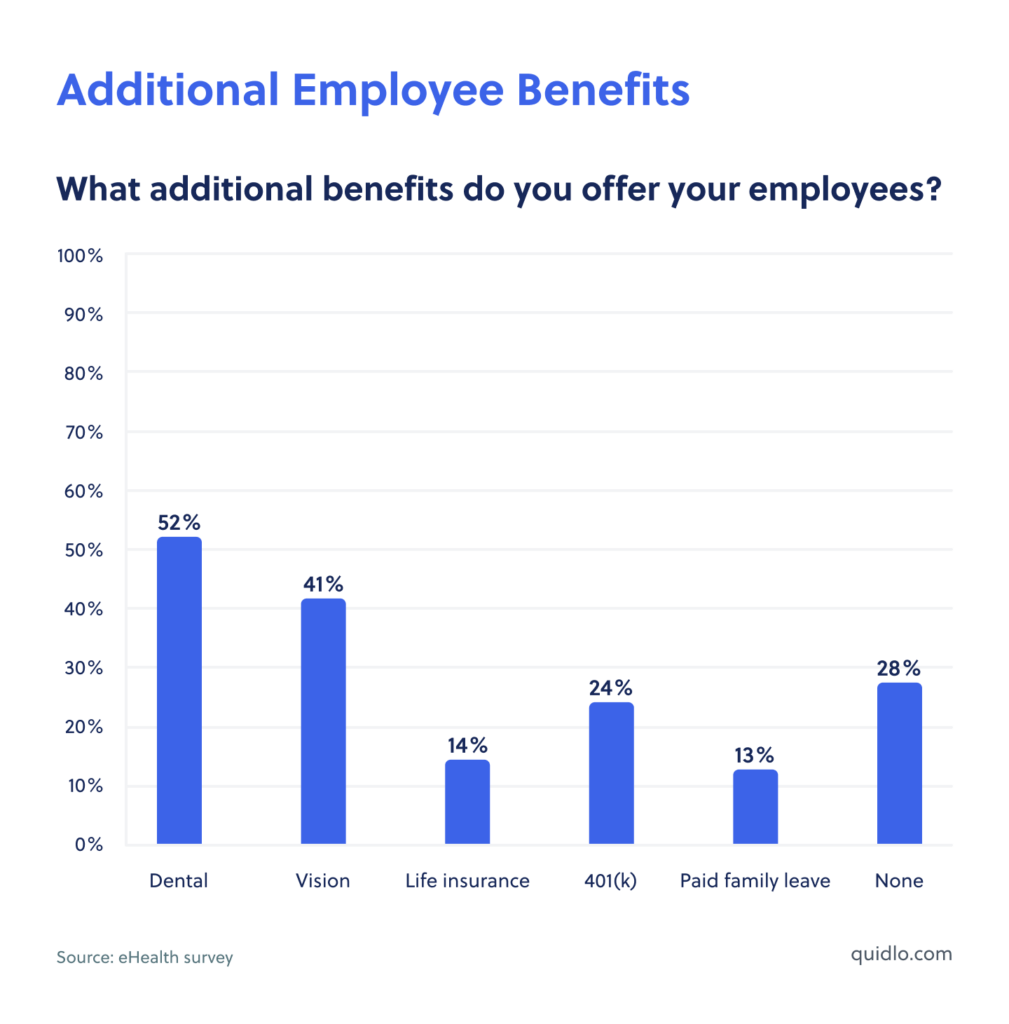
The more benefits you offer, the more likely you are to attract the best talent and improve your employee satisfaction.
Is It Better to Be a Part-time or Full-time Employee?
From the employee’s perspective, there are benefits and drawbacks to both part-time and full-time work; it often depends on the individual and their needs. Below is a breakdown of the benefits and drawbacks of both part-time and full-time work.
Benefits of part-time work
Here are the major benefits of part-time work for employees:
Better work-life balance & flexibility
If you only work part-time, you have more time to fulfill your aspirations and spend time with family and friends. The flexibility of a part-time job means you can work around commitments like school runs and hospital visits.
Less stress
If, for example, you only work 25 hours a week, you have more time to recover and relax than a full-time employee. Having time to recover means you are less likely to stress about work.
Improve time-management skills
If you only have a limited number of hours to complete your work objectives, you will learn to manage your time effectively.
Drawbacks of part-time work
Here are the disadvantages of part-time work:
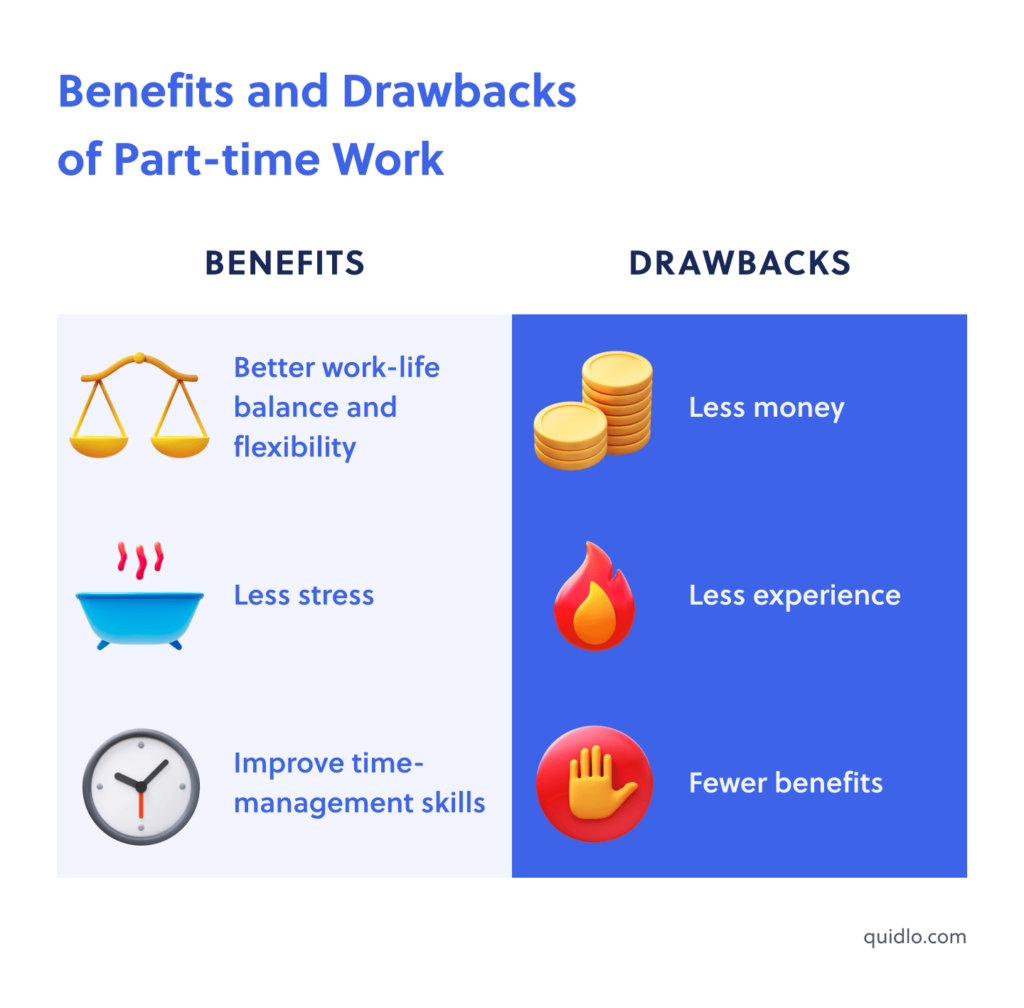
Less money
The obvious drawback of working part-time hours is you will earn less than your full-time counterparts. But working part-time means you also have the opportunity to earn money on the side through other ventures.
Less experience
Part-time employees spend less time on the job and are, therefore, less experienced. When it comes to applying for jobs in the future, you will have less experience than some of your peers.
Fewer benefits
The vast majority of part-time jobs will have fewer benefits than full-time jobs. Part-time roles may not offer health insurance, paid vacations, and a pension.
Benefits of full-time work
These are the top benefits of full-time work:
Higher, steadier income
Most professional full-time jobs are salaried, so you will receive the same amount of money each month, making budgeting and long-term planning easier. You will also earn more doing full-time hours.
Better benefits
You will be legally entitled to basic healthcare and family and medical leave as a full-time employee. You are also far more likely to receive additional benefits like pension schemes, comprehensive healthcare, and paid vacation days.
Career advancement opportunities
Businesses are more likely to invest in their full-time employees, and promotions are more likely. Working full-time also gives you more experience, which helps with career advancement.
Fixed schedule
Flexible schedules have their advantages, but knowing when you are working has its perks, too. It can be easier to plan your life if you know when you’re working and when you’re not. Full-timers can even utilize flextime working so they can slightly adjust their schedule when they need to.
Professional relationships
The relationships you make at work are a huge part of your life. After all, you are spending 40 hours a week at work.
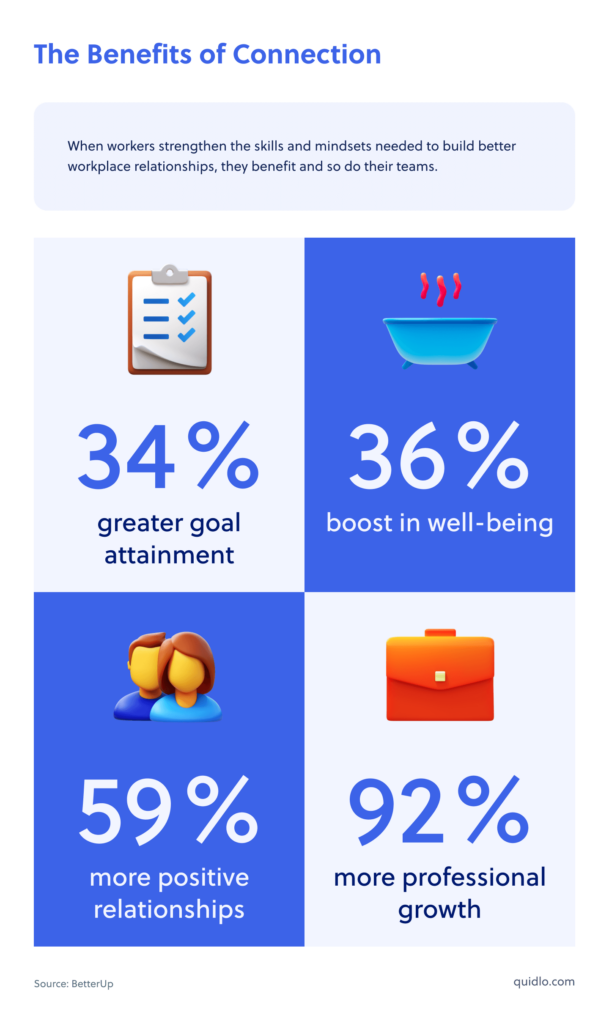
Being full-time helps develop professional relationships to a fuller extent. Strong professional relationships widen your career network and make being at work easier.
Drawbacks of full-time work
Here are the major issues of being a full-time employee:
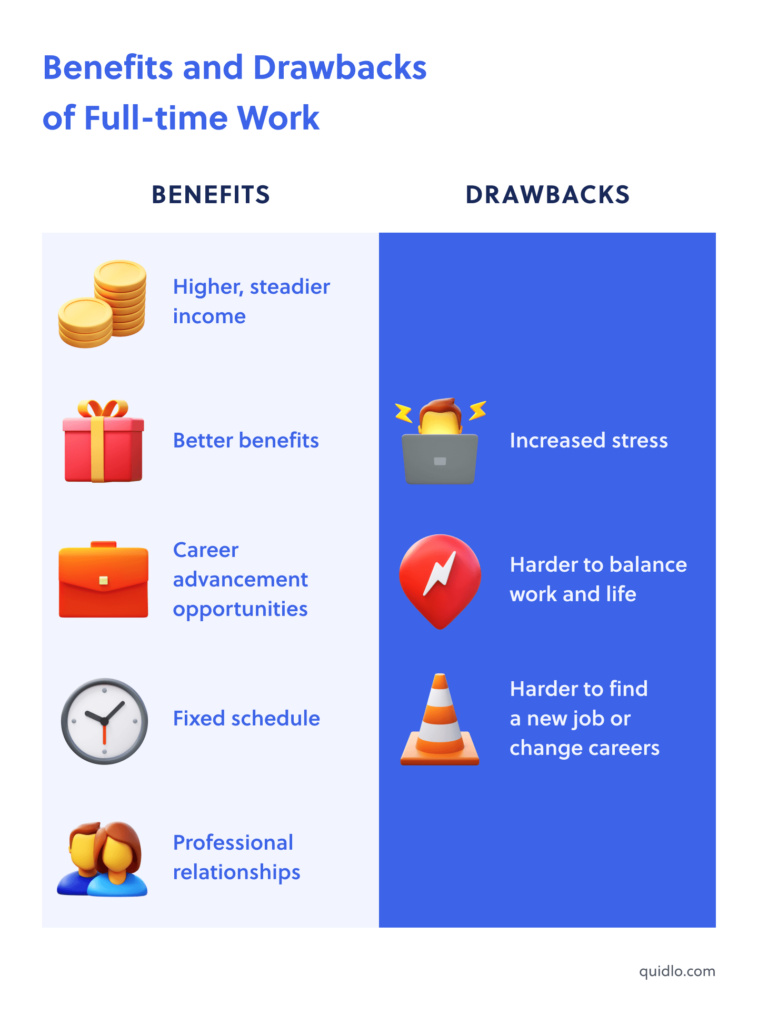
Increased stress
As mentioned earlier, the more you work, the more likely you are to stress.
Harder to balance work and life
If you have a demanding job and work around 40 hours a week, you have far less time for family, leisure, and personal growth than a part-timer. Those expected to answer calls and emails outside of work feel this even more.
Harder to find a new job or change careers
If you are unsatisfied with your job, having a full-time job can make it more difficult to find a new one. Sure, being in full-time employment looks good to new employers, but you simply won’t have as much time to find a new job compared to a part-timer. As they say, finding a job is a full-time job in its own right.
Should You Hire Part-time or Full-time Employees?
There are pros and cons to hiring both part-time and full-time employees. Let’s start with the part-time employees.
Pros of hiring part-time employees
Let’s start with an obvious one:
Less expensive
Part-time employees require less compensation as they work fewer hours. If you don’t have much room in your budget to hire an urgently needed employee, you can hire a part-timer for less money.
If you set measurable goals for your part-time employee, it can even be more efficient, as employees with many hours can end up wasting time on the job.
Acquire a specialist on a budget
You may not be able to afford a specialist in a full-time role, so hiring part-time allows you to get the specialized talent you wouldn’t otherwise be able to afford.
An experienced part-timer can even outperform a college graduate working full-time in some cases.
Flexibility
Part-time work schedules allow for greater flexibility. If you have an urgent project on the horizon, you can schedule your part-timers to fill the gaps and get the job done.
Savings on benefits
Although it is wise to offer your part-time employees some benefits, part-timers don’t expect the level of benefits a full-time employee receives. Therefore, you save costs on hiring part-time employees.
Cons of hiring part-time employees
Not as loyal
Part-time employees are often less dependent on their part-time job compared to full-time employees. Part-timers may have other income sources or a partner that is the main breadwinner.
Therefore, they are more likely to leave their position if they encounter stress or difficulty in the workplace compared to a full-time employee.
Limited availability
Although part-time employees can be more flexible, they are usually still limited to a maximum number of hours a week. Part-timers may have other commitments that prevent them from putting in the time the company needs to complete a big project.
Less Knowledgeable
If an employee only works part-time, they are likely to have less knowledge about products, procedures, and long-term strategies compared to a full-time employee. Full-time employees have more time to familiarize themselves with such things.
Pros of hiring full-time employees
Scheduling is easier
If your whole team is full-time, scheduling meetings is much easier, as all your employees are working the same hours.
More loyal
Full-time employees are more dependent on their jobs and benefits, so they’re more likely to be committed and weather hard times.
Higher levels of productivity
Productivity factors like collaboration are far easier with a team of full-time employees. Collaboration is far easier when all employees are in the office at the same time, and they only have one job to focus on. Full-timers can also finish a project faster as they simply have more time to complete it.
More Knowledgeable
Full-time employees have more time to familiarize themselves with how the business runs compared to part-time employees.
Cons of hiring full-time employees
Higher costs
Naturally, you have to pay full-time employees more as they work more hours per week. But you need to consider the cost of benefit packages, as full-time employees will be entitled to more benefits than part-timers.
Burnout
Working full-time, particularly in a stressful job, makes burnout more likely. Stressed and exhausted employees are less productive and more likely to cause interpersonal issues with other employees.
Which Types of Jobs are the Most Suitable for Part-time?
When most people think of part-time jobs, they think of college student-type jobs like retail, customer service, and hospitality. These jobs are suited to part-timers, but they aren’t the only jobs you can do on a part-time basis. The truth is most jobs can be done part-time.
Jobs like marketing analyst, graphic designer, lecturer, and data scientist can be done part-time.
Remember, there are lots of companies that can’t afford to employ someone full-time and are looking for cost-effective part-time alternatives for all sorts of roles. Often companies will want a specialist on a part-time basis, so if you consider yourself a specialist, it may be easier to find a part-time job than you think.
Part-time vs Full-time: Summary
Part-time and full-time are different in many respects. Different laws and regulations exist for each work mode, hours worked, and schedule. The benefits and remuneration you receive from each work mode are different as well.
After reading this blog, you should have a better understanding of the difference between part-time and full-time employees and the pros and cons of each from both the employee’s and employer’s perspectives. It’s hard to decide if you want to work part-time or full-time and whether you should hire part-time or full-time. But with the right information, it’s a little easier.
Hopefully, you’ll find this information helpful enough to make the right choice for you or your company.




